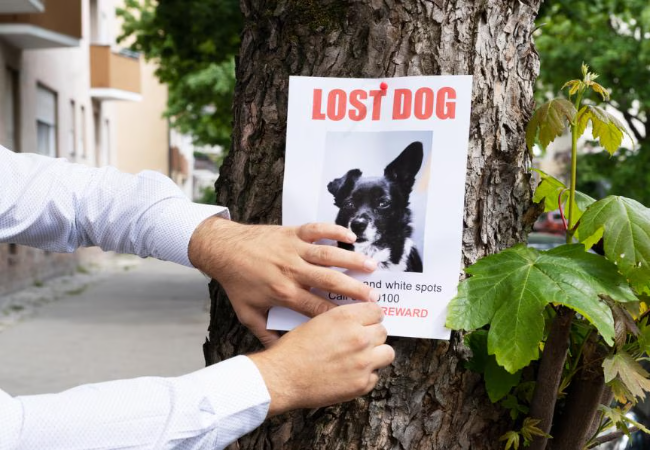How to Find a Lost Dog in 2025: Vet Approved Plan with Proven Search Strategies 🐾🔍

In this article
How to Find a Lost Dog in 2025: Vet Approved Plan with Proven Search Strategies 🐾🔍
By Dr. Duncan Houston BVSc
Losing a dog is a heart-stopping, anxious experience. But with a clear plan—grounded in veterinary insight and proven tactics—you can significantly increase your chances of reuniting. This ultimate guide brings together immediate steps, scent-based lures, technology & trackers, and expert team support like search dogs and drones. Let’s map out every stage to bring your dog safely home.
1. ⏱️ First 24 Hours: Act Fast!
The sooner you start, the better your odds (most pets are found within 24–48 hrs).
- Contact and *visit* every local shelter and animal control agency—visual ID is more reliable than phone descriptions.
- Report your dog missing and update microchip company info—double-check chip registration details.
- Print and post flyers with a clear photo, description, notable traits, collar info, your phone—distribute within a 2‑mile radius including at kid height for visibility.
- Speak to neighbors and leave flyers and scent items (bedding or your worn shirt) in your yard—they can follow scent trails.
2. 📲 Social Media & Lost-Pet Networks
Online platforms can amplify your search within minutes:
- Post in local **Lost & Found Pet** groups, city/county pages, and platforms like Petco Love Lost, Nextdoor, Facebook Marketplace, Craigslist.
- Upload your dog’s details to Petco Love Lost and Petkey to alert vet offices and shelters nearby.
- File Automated Alerts via Petco Love Lost—rescues and community members are notified in real time.
- Check daily and respond quickly to any sightings; keep posts updated and share widely.
3. 🐕 Use Scent Strategy & Lures
- Leave scented items like bedding and worn clothes—these scent trails draw dogs home.
- Hang stinky but appealing food like cooked chicken or grilled sausage—they work like “scent lures”.
- Shake toys or squeakers—distinctive sounds reassure them and coax them out of hiding.
- Ask a calm, confident dog to help lure a shy or frightened dog out of hiding.
4. 🚨 Strategic Searches & Trapping
- Search during dawn/dusk—they move most then.
- Don’t chase them—remain calm, squat low, use soft voice.
- Place motion-activated cameras near scent pickups to locate movement.
- Use humane traps with food scent and bedding—check frequently and release non-target animals.
5. 📡 Technology & Advanced Assistance
- Hire search teams with scent-tracking dogs (bloodhounds) or professional pet trackers—higher success by identifying scent trails.
- Engage drone services: thermal drones can locate dogs in wilderness settings with high success rates.
- Consider GPS trackers if your dog has one—check cellular or satellite apps for last seen location.
6. 🐶 Breed & Personality Considerations
- Shy or stressed dogs often hide—use quiet, scent-based recovery instead of vocal yelling.
- Fearful breeds (e.g. Greyhounds, Shepherds) may not approach strangers—focus on scent/presence methods.
- The presence of another calm, confident dog can reassure them to come out.
7. ✅ Keep Detailed Records
- Log sightings: time, area, photo if possible.
- Track when you distributed flyers and posted online.
- Include volunteer support and contact info from neighbors/pet groups.
- Stay organized—detail can make follow-up easier.
8. 🧘 Staying Calm & Safe
- Don’t call their name—use a calming word and avoid panic voice tones.
- Use walking style, body language, and lifting scent and sound to draw them back.
- Don’t chase—this may push them farther away.
- Keep doors and gates open; roaming dogs may circle home again.
9. 🛒 Vet, Pet Services & Apps to Use
- Ask A Vet App: immediate advice on search planning, safety, and lost-pet emergencies.
10. 🔒 Once They’re Home—Safety & Reunification
- Bring them in slowly; allow sniffing and regrouping before joyful greetings.
- Check for injuries, fleas/ticks, dehydration, and stress—visit vet if needed.
- Reaffirm microchip, collar contact info, and enroll in recovery services.
- Reintroduce training: recall, boundaries, escape-proof fencing.
📌 Key Takeaways
- Start immediate action: visit shelters, alert chip registry, distribute flyers.
- Use scent, food, and sound to lure them—no panicked chasing.
- Leverage social media, trackers, drones, search dogs, and humane trapping.
- Tailor search to your dog’s personality and breed.
- Stay calm, organized, and resilient—95% of pets are reunited if owners act fast.






